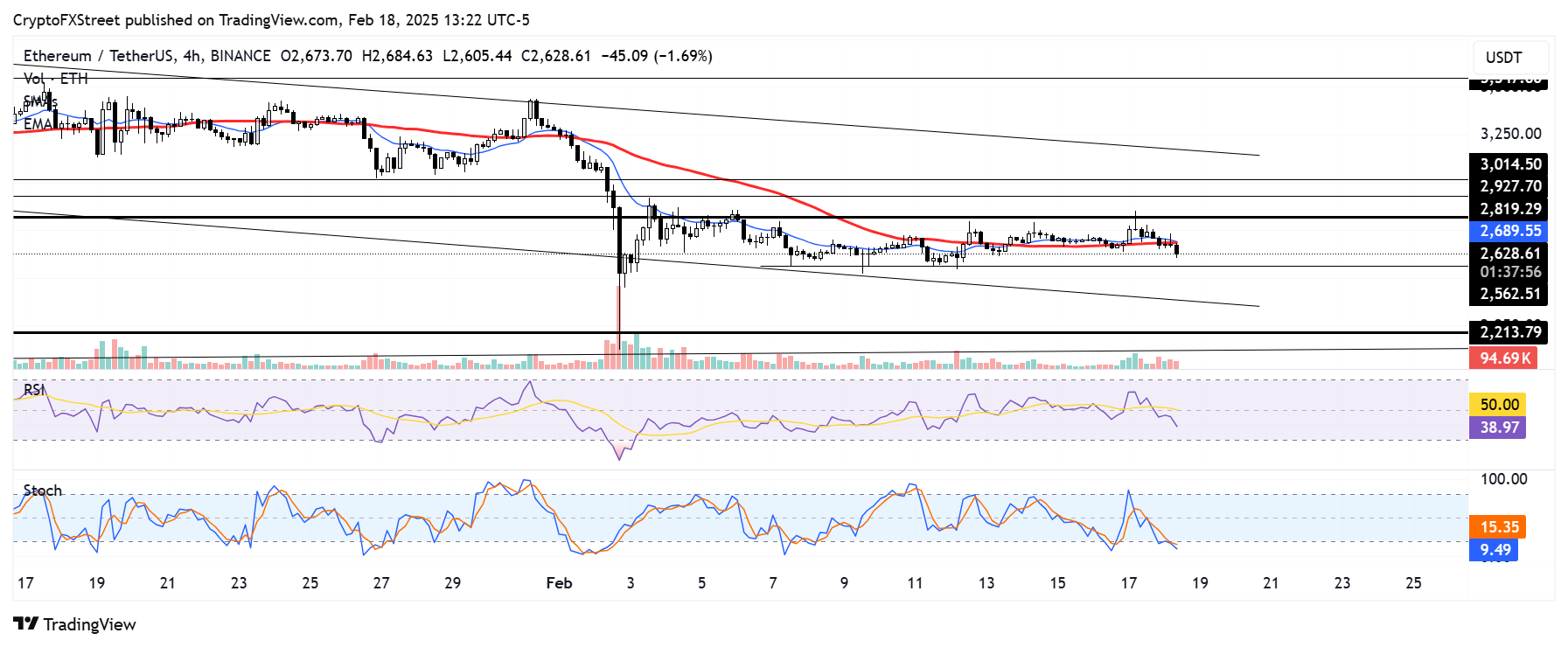Ethereum Price Forecast: Whales secure profits, sparking 4% dip with over $1 billion worth of ETH distribution
Ethereum price today: $2,620
- Ethereum whales booked profits from its recent rise with over $1 billion worth of ETH redistribution.
- Options data shows a 30% chance for ETH to smash the $3,000 level before the end of Q1.
- Ethereum could find support near $2,560 as its consolidation spans into the third week.
Ethereum (ETH) dipped 4% on Tuesday following rising selling activity from whales who have cut their holdings by over $1 billion in the past two days. Despite the recent selling activity, ETH's exchange supply shows investors still hold a long-term bullish bias.
Ethereum whales book profits, redistribute $1 billion worth of ETH
Ethereum whale addresses have been shedding their holdings at an accelerated pace in the past two days, per Santiment data. These addresses holding between 10K-100K ETH have distributed nearly 400K ETH worth over $1 billion during the period.
 [18.26.22, 18 Feb, 2025]-638755014465576816.png)
ETH Supply Distribution (10K-100K) & Age Consumed. Source: Santiment
The accompanying spike in the Age Consumed metric shows that the distributed coins may have been previously idle tokens intended for long-term holding.
Age Consumed measures the number of coins changing addresses daily multiplied by the days they last moved.
The Network Realized Profit/Loss showed investors secured $77 million in profits — a one-week high — from the distribution, potentially spurring ETH's recent decline.
 [18.42.22, 18 Feb, 2025]-638755014917496427.png)
ETH Network Realized Profit/Loss. Source: Santiment
The top altcoin began the week on a positive note, rising to a 12-day high of $2,850 while outperforming major cryptos including Bitcoin, XRP and Solana. However, it has since retreated, sustaining nearly a 4% decline in the past 24 hours.
Despite the recent selling activity, Ethereum investors have continued to show a long-term bullish bias by increasing their exchange withdrawals.
Investors have withdrawn nearly 740K ETH from exchanges in the past two weeks, stretching the percentage of ETH's total supply in private wallets to 84.3%, per CryptoQuant's data.
On the other hand, the low exchange supply may not be entirely bullish due to ETH's usage across the decentralized finance (DeFi) landscape. Investors could even short ETH via decentralized perpetual exchanges or lending and borrowing protocols.
Meanwhile, crypto derivatives exchange Derive founder Nick Forster shared in a note to FXStreet that "there's now a 30% chance [among options traders] ETH will hit above $3K by the end of the quarter, up from 28% last week."
Ethereum Price Forecast: ETH could find support at $2,560
Ethereum experienced $55.08 million in futures liquidations in the past 24 hours, per Coinglass data. The total amount of long and short liquidations accounted for $41.16 million and $13.92 million, respectively.
The top altcoin is struggling to find direction after seeing a rejection near the $2,850 resistance.
ETH is now stretching its consolidation between $2,500 and $2,850 into the third week, mirroring Bitcoin and the wider crypto market's lack of directional bias.

ETH/USDT 4-hour chart
If history repeats, ETH could stretch the horizontal move beyond Q1 2025 as it did between August and November 2024 when it breached the $2,850 level.
With ETH's consistent selling pressure near $2,850, a strong market catalyst may be needed to spur a breakout.
On the downside, ETH could find support near the $2,560 support level. If ETH breaches this level, it could bounce off the lower boundary of a descending channel.
The Relative Strength Index (RSI) is below its neutral level, indicating dominant bearish momentum. Meanwhile, the Stochastic Oscillator is in the oversold region, signaling a potential reversal.
A daily candlestick close below $2,200 will invalidate the thesis.
Ethereum FAQs
Ethereum is a decentralized open-source blockchain with smart contracts functionality. Its native currency Ether (ETH), is the second-largest cryptocurrency and number one altcoin by market capitalization. The Ethereum network is tailored for building crypto solutions like decentralized finance (DeFi), GameFi, non-fungible tokens (NFTs), decentralized autonomous organizations (DAOs), etc.
Ethereum is a public decentralized blockchain technology, where developers can build and deploy applications that function without the need for a central authority. To make this easier, the network leverages the Solidity programming language and Ethereum virtual machine which helps developers create and launch applications with smart contract functionality.
Smart contracts are publicly verifiable codes that automates agreements between two or more parties. Basically, these codes self-execute encoded actions when predetermined conditions are met.
Staking is a process of earning yield on your idle crypto assets by locking them in a crypto protocol for a specified duration as a means of contributing to its security. Ethereum transitioned from a Proof-of-Work (PoW) to a Proof-of-Stake (PoS) consensus mechanism on September 15, 2022, in an event christened “The Merge.” The Merge was a key part of Ethereum's roadmap to achieve high-level scalability, decentralization and security while remaining sustainable. Unlike PoW, which requires the use of expensive hardware, PoS reduces the barrier of entry for validators by leveraging the use of crypto tokens as the core foundation of its consensus process.
Gas is the unit for measuring transaction fees that users pay for conducting transactions on Ethereum. During periods of network congestion, gas can be extremely high, causing validators to prioritize transactions based on their fees.

